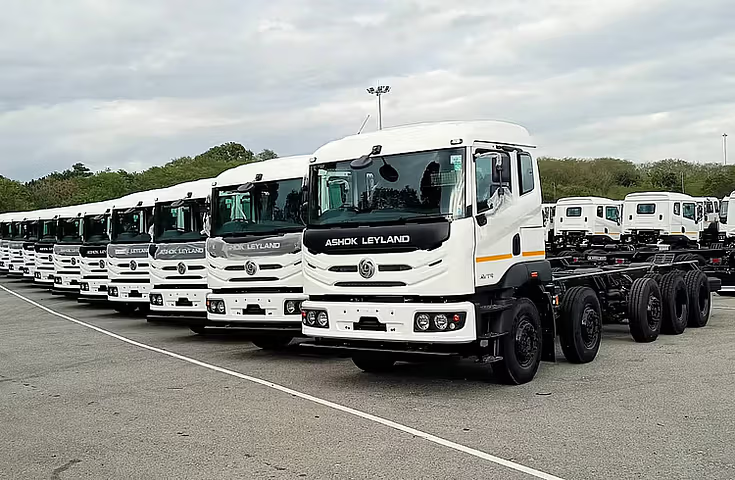Ashok Leyland Q4 FY25 Results Beat Estimates

Ashok Leyland Ltd., one of India’s leading commercial vehicle manufacturers, posted a robust performance in the fourth quarter of FY25, outperforming market expectations. The company reported solid growth in net profit and improved operational metrics, driven by strategic efficiency gains and a stronger product mix. These results indicate a promising turnaround in operational execution and set a more stable course for long-term growth.
Strong Profit Growth and Revenue Performance
For the three-month period ended March 31, 2025, Ashok Leyland recorded a standalone net profit of ₹1,246 crore, marking a 38.4% increase year-on-year. The net profit significantly exceeded Bloomberg analysts’ consensus estimate of ₹1,100 crore, signaling stronger operational execution and effective cost management.
Revenue grew by 5.7% year-on-year to ₹11,907 crore, slightly below the street’s expectation of ₹12,065.5 crore. Despite missing the top-line forecast, the company maintained profitability through robust margin expansion and an optimized product mix.
Impressive Margin Expansion
Ashok Leyland reported a 15% operating margin in Q4 FY25, which represented a 100 basis point improvement year-on-year and exceeded brokerage firm CLSA’s estimate by 104 basis points. This growth stemmed largely from improvements in gross margin and lower overall cost absorption.
Gross margin reached 29.4%, aided by a richer product mix, strong growth in high-margin segments such as spares (up 15%) and engine revenue (up 9%). The company emphasized the continued focus on cost controls and optimization of supply chains, which further contributed to margin resilience.
Operational Efficiency Driving Bottom Line
Lower tax incidence and disciplined cost control helped Ashok Leyland boost its bottom line. The company made significant strides in streamlining its operations over the past year, implementing technology-driven manufacturing improvements and tighter inventory management across dealerships.
Operational efficiency also improved through better logistics management and increased automation in its facilities. These enhancements not only supported margin growth but also allowed for faster production cycles and reduced downtime, resulting in better service and product availability.
Segmental Performance Highlights
While the commercial vehicle industry faced cyclical challenges, Ashok Leyland continued to strengthen its performance across key verticals.
- Medium and Heavy Commercial Vehicles (M&HCV) remained the primary revenue contributor despite a slight volume dip.
- Spare parts and aftermarket services witnessed robust growth, providing high-margin support to the business.
- The engine business contributed to diversification, growing 9% in the quarter and reinforcing the company’s manufacturing ecosystem.
The company strategically pushed premium product offerings and newer technologies, which helped in balancing the moderate volume growth with higher realization per vehicle.
Brokerages Turn Positive on Outlook
Brokerage house CLSA upgraded its rating on Ashok Leyland stock from ‘Underperform’ to ‘Hold’, citing better-than-expected margin execution and a constructive medium-term outlook. CLSA also revised its target price upward to ₹225 from ₹190, acknowledging the company’s capability to sustain operating efficiencies in a volatile macro environment.
Despite this upgrade, CLSA warned of potential headwinds in FY26. The brokerage forecasted a 5% decline in M&HCV volumes, attributing it to factors such as the re-imposition of steel safeguard duties and regulatory changes like mandatory air-conditioned cabins for trucks. These new rules are likely to increase manufacturing costs and vehicle prices.
However, CLSA also predicted a recovery starting FY27, driven by infrastructure spending, replacement demand, and increased freight movement with economic stabilization.
Leadership Commentary and Strategic Focus
Ashok Leyland’s management reiterated their commitment to long-term growth, highlighting the company’s strategy to diversify revenue streams and build a robust portfolio. Their plan focuses on:
- Strengthening electric and alternative fuel vehicle capabilities.
- Expanding market share in LCVs and export territories.
- Enhancing the digital interface for fleet owners and drivers.
The management team also emphasized scaling up investments in research and development, particularly in EVs and hydrogen-powered engines, which aligns with the Indian government’s green mobility agenda.
Market Position and Industry Context
Ashok Leyland stands as the second-largest commercial vehicle manufacturer in India and holds a strong market presence in the medium and heavy truck segment. The commercial vehicle industry in India continues to navigate post-pandemic recovery dynamics, fluctuating input costs, and evolving regulatory mandates.
Despite these challenges, Ashok Leyland’s consistent focus on value engineering, product innovation, and aftermarket support allows it to remain resilient and competitive.
Competitors such as Tata Motors and VE Commercial Vehicles are also ramping up efforts to tap into the evolving demand trends, particularly around electric mobility. However, Ashok Leyland’s aggressive strategy in premium product segments and international markets provides a unique edge.
Investor Takeaways and Future Outlook
The Q4 FY25 results confirm that Ashok Leyland has made significant strides in improving profitability and operational strength, even as revenue growth stays modest. Analysts believe that the company has successfully entered a stronger operational phase, with better clarity on margins and improved earnings visibility.
Key factors for investors to monitor in the coming quarters include:
- Impact of new cost regulations such as the AC cabin rule.
- Raw material price volatility, especially in steel and alloys.
- Commercial vehicle demand cycle trends, especially in infrastructure-heavy states.
- Expansion of EV and alternate fuel portfolios and their acceptance in the fleet market.
While FY26 may present some volume challenges, the broader picture from FY27 onward appears optimistic, thanks to industry revival prospects, strong balance sheet fundamentals, and rising demand for efficient and compliant commercial vehicles.
Conclusion
Ashok Leyland’s Q4 FY25 performance underscores the company’s resilience and adaptability in a competitive and evolving automotive landscape. With a 38.4% profit growth, 15% operating margin, and clear visibility into cost control strategies, the truck-maker has reasserted its leadership in value-driven growth.
As the company braces for short-term regulatory and cost headwinds, its strategic pivot toward premium offerings, aftermarket services, and emerging mobility solutions positions it well for long-term success. For investors, Ashok Leyland remains a solid story of margin discipline, engineering excellence, and growth ambition in India’s transport and logistics sector.













